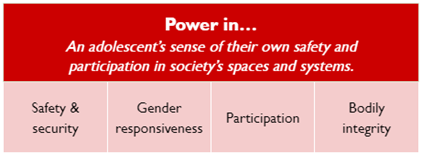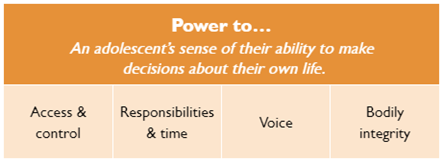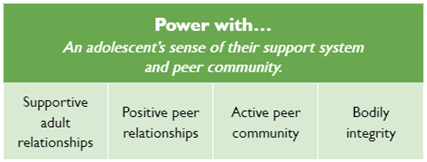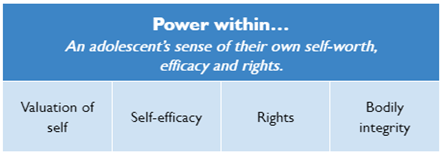
Girls’ Power Index (GPI)
Indicator Name
Indicator ID in PRIME
Definition
The Girls' Power Index (GPI) is an indicator that captures a unique data set that is often overlooked: perceptions of their own power. It complements standard indicators, such as those measuring behaviour, knowledge and skills, by offering insight into adolescent girls’ internal sense of their own bodily integrity, decision-making power, self-worth, self-efficacy, rights, support system, peer community, safety, and participation. By centering the perspectives and experiences of adolescent girls themselves, the GPI can be used to bridge gaps between adolescent girls’ perceptions and targeted outcomes.
The GPI defines and analyzes perceptions of power through four dimensions:




Measuring empowerment is complex, and the Power Index is an accessible and adaptable tool that supports its measurement. This quantitative composite index uses Likert scales to measure girls’ attitudes, perceptions, and beliefs across the 4 domains of power (Power To, Power With, Power Within, Power In).
For this indicator, ‘High’ overall empowerment is defined as scoring between 90-112 points on the GPI. This is compared to moderate empowerment (56-89 points) and low empowerment (0-55 points). To generate these scores, participants respond to a series of 28 statements reporting whether they Strongly agree (4 points), /Always, Agree (3 points), /Often, Disagree (2 points), /Rarely, Strongly disagree (1 point) /Never or Don’t know/Refused (0 points).
While this indicator is focused on girls' empowerment, girls are not a homogenous group. It is therefore important to disaggregate this indicator by additional factors (e.g. disability, migration status, race/ethnicity, socio-economic status, marital status, etc.) that are relevant to your specific project/program.
Numerator
Number of surveyed girls who report high GPI scores in the Power index (score 90-112 points)
Denominator
Total number of girls surveyed (size of a representative sample of supported individuals)
Measured through the Girls' Power Index. This tool was drafted, piloted and used by SC Canada since 2020 in various projects and hasve been since been validated and updated by an external consultancy team in 2023. Currently the MOV is available for Education (access to education) and Health (ASRH) thematic works. However if the implementing office decides to use it in other themes, please reach out to Gender Equality Leads at SC Canada: Sarah Anderson (sanderson@savethechildren.ca) and/or Dominique LaRochelle (dlarochelle@savethechildren.ca)
LINK to the tool.
Indicator Prioritisation
Level of Indicator
Indicator Context Type
Theme
Sub Theme
Cross-Cutting Themes
Total Reach Indicator
Context
Frequency of Data Collection
Unit of Measure
Data Format
Direction of Desired Change
Number of Decimal Points
Indicator is Rounding
Nature
Recommended Disaggregations
Other Survey Tool
Form Questions
Likert scale statements (Strongly agree, Agree, Disagree, Strongly Disagree) across 4 domains, approximately comprising 28 statements

